This traditional St. Patrick’s Day stew is a true taste of Ireland, combining tender meat, hearty vegetables, and the rich, distinctive flavor of Guinness Beer. Simple to prepare and brimming with flavor, this stew is a celebration in itself—no matter where you are in the world, it brings a piece of Irish warmth to your kitchen. Let’s dive into making this St. Patrick’s Day one to remember with a dish that’s as nourishing as it is delicious.
Complete your St. Patrick’s Day feast with corned beed and cabbage, colcannon, and soda bread.
Why You’ll Love This Recipe
- Rich in flavor with the combination of meat, vegetables, and Guinness Beer.
- Can be made on the stovetop, instant pot or slow cooker!
- Tastes even better the next day and is ideal for meal prepping.
- Easy to adapt with different veggies or non-alcoholic substitutes for Guinness.
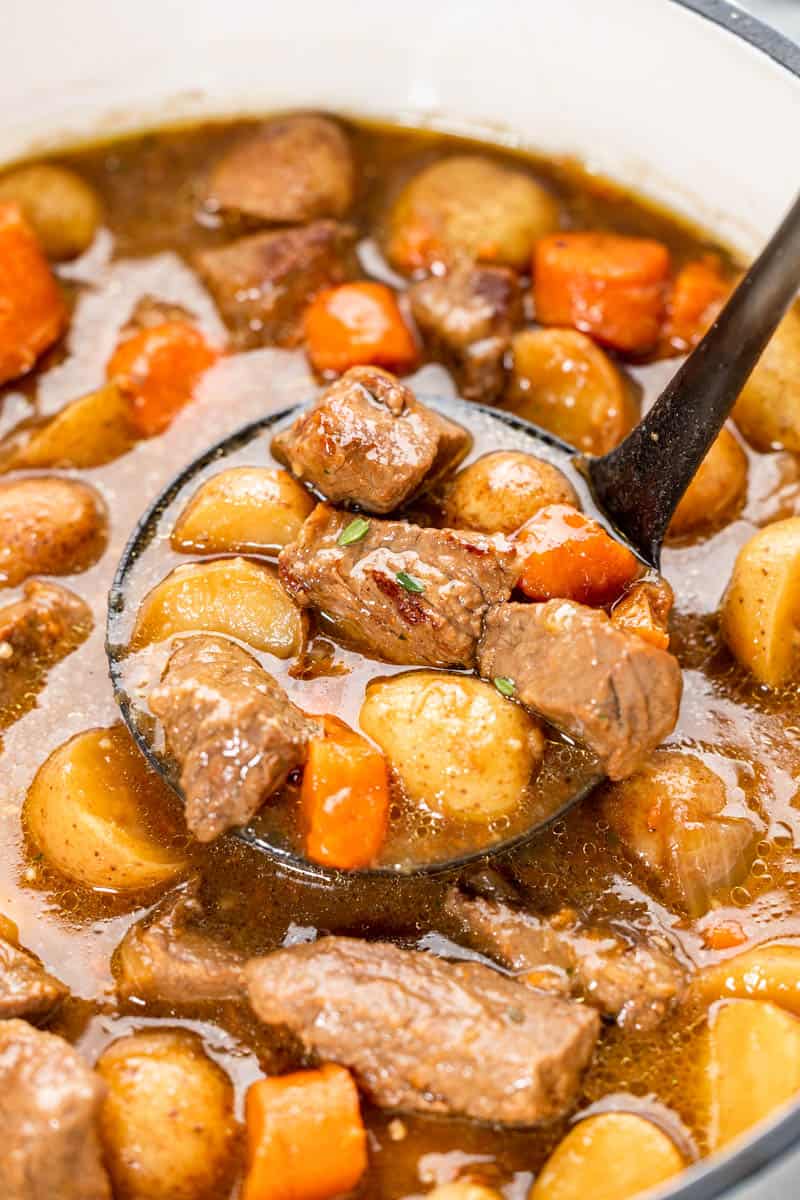
Irish Stew Recipe
Stew in the winter is a necessity. It is warming on a chilly day, and fills my family’s bellies with hearty meat and veggies that we crave in these colder months. Stews like this make life just a little bit easier, because there isn’t any scrambling to get dinner on the table! If you prep and start cooking Irish stew early in the day, all that’s left is hands-off simmering on the stove to bring out all of those amazing flavors.
Ingredients & Substitutions
- Meat: Lamb shoulder, mutton, or beef chuck adds richness. For a lighter version, chicken thighs can be used.
- Potatoes and carrots: Provide texture and absorb the stew’s flavors beautifully. Red or gold potatoes will hold up better in stew. Turnips or parsnips are great alternatives.
- Onion and garlic: The aromatics base that starts the flavor build. Leeks can be substituted for a milder taste.
- Guinness Beer: Adds a unique, malty depth. Non-alcoholic stout or additional beef broth can be used as substitutes.
Using substitutes may affect final taste and texture.
Can I make Irish stew vegetarian?
Yes, substitute the meat for mushrooms or lentils and use vegetable broth.
What beer and wine should I use in Irish Stew?
Guinness beer is the most common, and in our opinion, the best beer for this Irish stew, as it is from Ireland. If you do not want to use Guinness you can also use any dark stout beer.
Any red wine can be used in this recipe, just make sure it is a wine you would drink (if you drink wine). We do not recommend cooking wine.
If you prefer not to cook with alcohol, you do not have to use beer and wine. Simply replace regular beer with non-alcoholic beer, or you can replace the beer and wine with additional beef broth.
History Lesson
Irish stew, traditionally known as “stobhach” in Gaelic, is a testament to the resourcefulness of Irish cooking. Originating as a peasant dish, it utilized readily available ingredients and could be left to cook slowly while the day’s work was done. The stew has evolved but remains a staple, symbolizing comfort and hospitality in Irish culture.
Instant Pot Instructions
- Pat the meat dry and sprinkle with kosher salt and pepper.
- Heat 2 tablespoons of oil in Instant Pot using the saute setting. Add meat in batches and brown on all sides. Remove to plate and repeat with remaining meat. Set aside.
- Add in 2 more tablespoons of oil. Add onion and cook for 5 minutes until softened, then add garlic, cook 3 minutes. Stir flour into the vegetable mixture and cook for 5 more minutes.
- Add Guinness beer stirring and scraping up browned bits on bottom of pan then add beef broth and red wine.
- Return browned meat to the pot, including any juices, along with carrots, potatoes, thyme and bay leaves.
- Secure lid and set to high for 1 hour. Then remove lid and simmer with Saute setting for a further 10-15 more minutes to thicken the stew.
Slow Cooker Instructions
- Pat the meat dry and sprinkle with kosher salt and pepper.
- In a skillet over high heat, heat 2 tablespoons of oil. Add the meat in batches and brown well all over. Remove the meat to a plate and repeat with the remaining meat.
- Transfer the browned meat to a slow cooker.
- In a small bowl, whisk together 1/2 cup of beef broth and 1/2 cup of cornstarch to make a slurry.
- Add all remaining ingredients, including the slurry, to the slow cooker.
- Set the slow cooker on high for 3-4 hours or low for 6-8 hours until the meat and vegetables are tender to your liking.
- Remove the lid for the last 30-45 minutes to help the broth thicken.
- Serve hot, garnished with chopped parsley.
Troubleshooting
- Stew too thin? Thicken with a cornstarch slurry (mix equal parts cornstarch and water, then stir into the stew).
- Meat not tender? Extend cooking time in 15-minute increments until the meat reaches the desired tenderness.
- Flavors too muted? Adjust seasoning with additional salt, pepper, or a splash of Worcestershire sauce for extra depth.
Tips From the Chef
- Brown the meat well: This step adds a rich flavor foundation.
- Cut vegetables uniformly: Ensures even cooking.
- Don’t rush the simmer: Slow cooking allows flavors to meld and deepen.
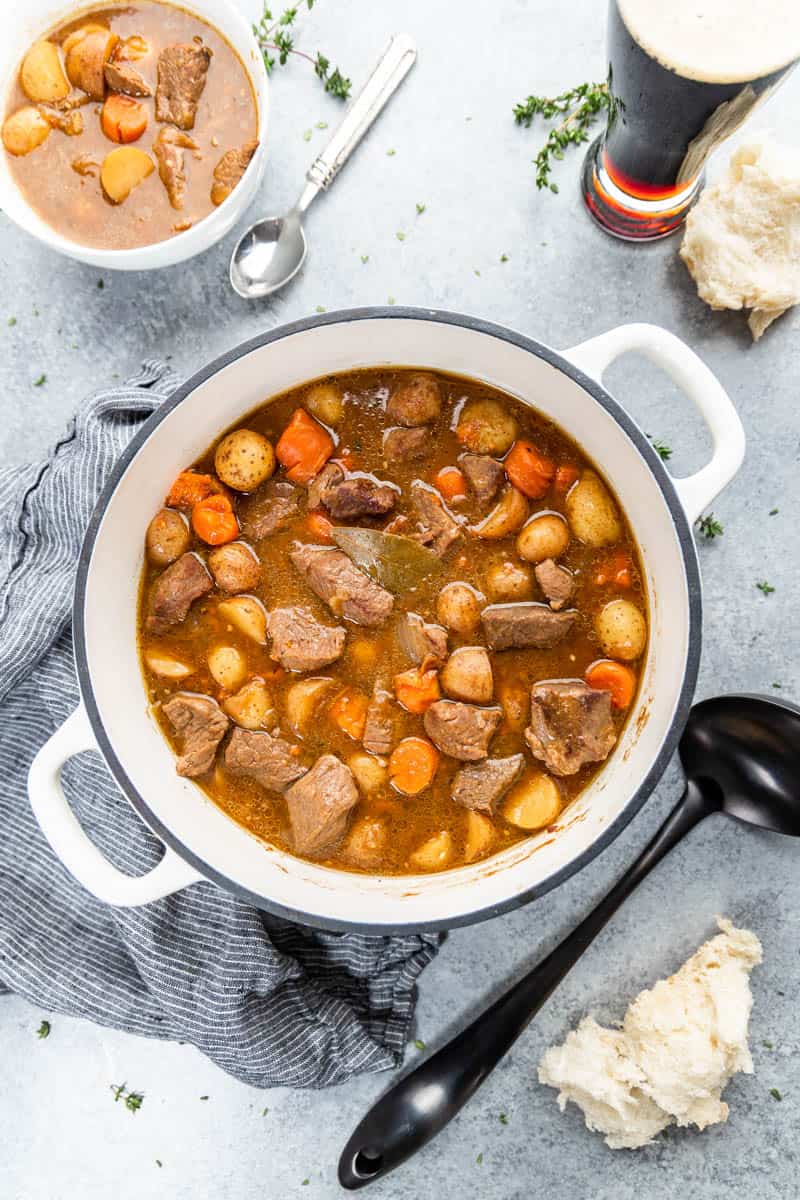
When is Irish Stew Finished Cooking?
- Color: The stew should have a rich, dark broth, indicating the flavors have concentrated.
- Texture: Meat should be fork-tender, and vegetables soft but not mushy.
- Aroma: A fully cooked stew will emit a warm, hearty aroma, inviting you to dig in.
Storage & Reheating Instructions
- Refrigerate: Cool the stew before storing it in an airtight container in the refrigerator for up to 4 days.
- Freeze: Freeze in portions for easy thawing. Use within 3 months for best quality.
- Reheating: Warm over low heat on the stove, adding a splash of broth if needed. For frozen stew, thaw in the refrigerator overnight before reheating.
More St. Patrick’s Day Recipes
Watch the video below where Caytlin will walk you through every step of this recipe. Sometimes it helps to have a visual, and we’ve always got you covered with our cooking show. You can find the complete collection of recipes on YouTube, Facebook Watch, or our Facebook Page, or right here on our website with their corresponding recipes.
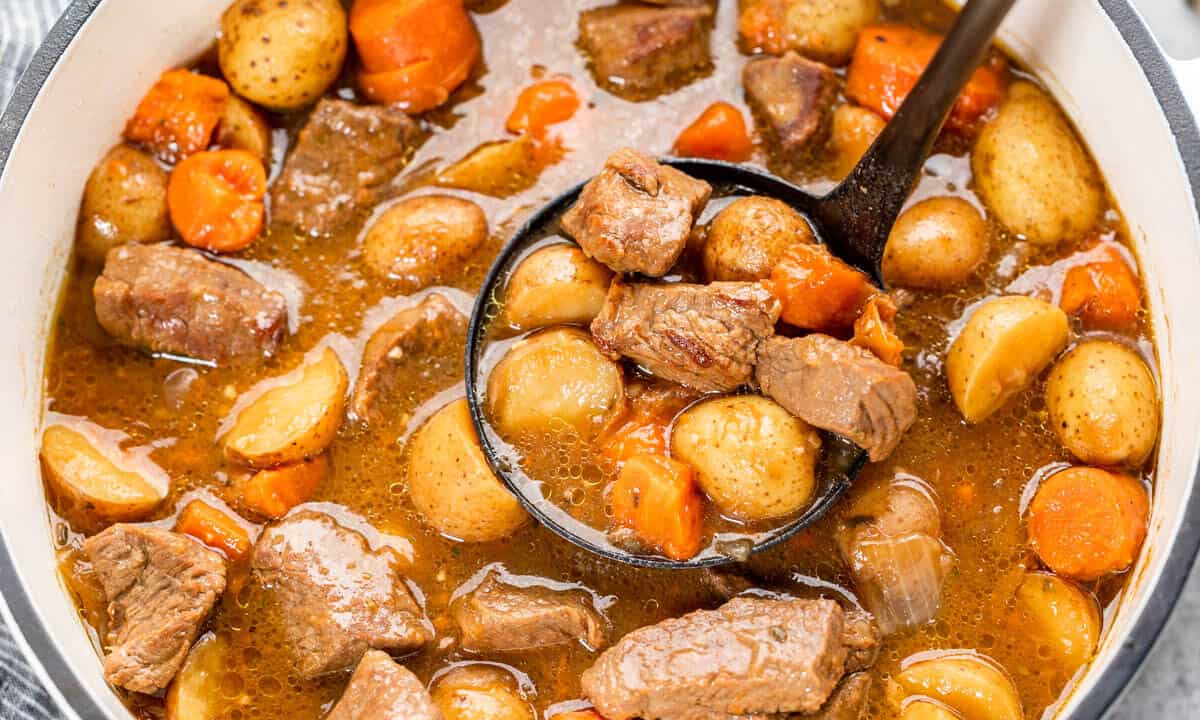
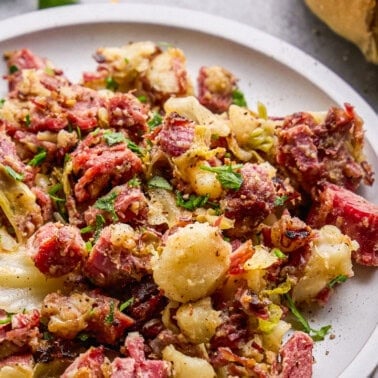

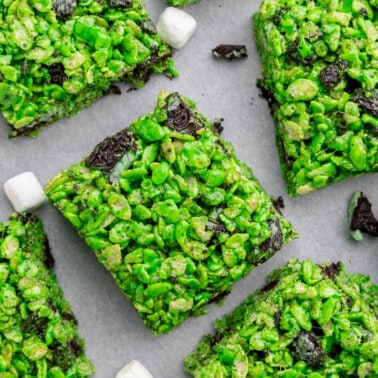
I made this for St Patrick’s day this year. My mom was born in Ireland and we love Irish stew. I would have given 5 stars, but have one suggestion to make it 5 stars. It needs more potatoes and carrots. I did 2 lbs of Yukon gold potatoes and the 4 carrots (large carrots at that) and found that my leftovers was 80% beef and gravy and no carrots or potatoes left. I added more to the left overs and it was perfect. Great flavor on this stew. I used Instapot directions and it worked perfectly!
No adequate words to describe this, it was SUPERB! Will be making recipe from now on.